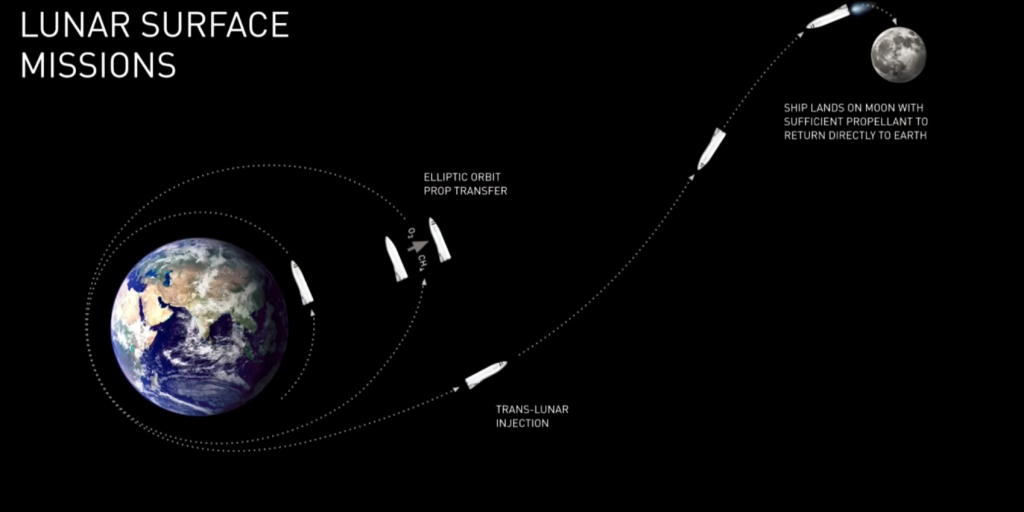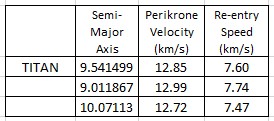Elon Musk’s big reveal at the 68th IAC, Adelaide 2017, was a Rock-star moment for all Space enthusiasts. On reflection an interesting slide, for me, was this one:
Not so much the destination, but the technique. Firstly, some basic performance details. The BFR carries 1100 tons of propellant, masses about 85 tons and carries 150 tons of payload. Its Raptor engines are designed for a specific impulse (Isp) of 375 seconds. To turn that into an exhaust velocity, multiply by the Earth’s gravity – in metric it’s 9.80665 m/s2 x 375 s = 3,677.5 m/s. Thus the mass-ratio is (1335/235) = 5.68, so the delta-vee available is 6,388 m/s. SpaceX think future Raptors can squeeze another 5-10 seconds of Isp out, but let’s use the above figure.
From LEO the initial push to launch into an ellipse to the Moon is about 2.75 km/s. To land directly on the Moon requires about 2.5 km/s, and thus about 2.5 km/s to launch back to Earth for an aerobrake return. You can see the basic problem if you want a round trip to the Moon – the delta-vee is 7.75 km/s, so the BFR is short by ~1.4 km/s. However the staging orbit doesn’t have to be a circular orbit in LEO. The trick in the diagram is that you can use a Highly Elliptical Orbit, that already swings out part way to the Moon. Thus, at its closest point to the Earth, perigee, the BFR is swinging past at 10 km/s. At its high point, apogee, there’s time to transfer propellant and fill the tank. Instead of 2.75 km/s for the Trans Lunar Insertion burn, the BFR might use 0.75 km/s, and the total round-trip delta-vee required is just 5.75 km/s. Not even a full tank of propellant required!
This technique allows the BFR to aim even further from the Sun, if we can rely on aerocapture or aerobraking at the destination. The Asteroids and the moons of Jupiter lack this option – though Jupiter itself *might* be useful. Saturn, however, has Titan, with a vastly extended atmosphere. How extended? On Earth the point of re-entry into the atmosphere is at the 125 km altitude mark, but on Titan that’s more like 1200 km.
Just how quickly can we get to Titan using a single BFR? With the available delta-vee there’s three options for a direct flight to Saturn from Earth orbit – a Hohmann Orbit, an Elliptical Orbit and a Parabolic Orbit. Travel time is dependent on where Saturn is in its orbit. Saturn gets as close to the Sun as just over 9 AU, averages about 9.5 AU and gets as far out as just over 10 AU. For the three options the travel times (in Julian Years) are:
As can be seen, the time-saving for the Elliptical vs the Hohmann trajectory is quite marked, but not much is gained by going fully parabolic. What do each of the options mean?
The Hohmann Orbit is the Minimum Energy Trajectory and basically it means taking an orbit that is an ‘average’ of the start and finish orbits. The travel time is half the period of that average orbit, thus traveling half the ellipse linking the two orbits.
The Elliptical Orbit is just one of an infinite family, between Hohmann and Parabolic, but in this case a particular choice is made – the semi-major axis of the ellipse is equal to the destination orbit. Thus the trip is, effectively, half the Hohmann trajectory – a quarter of the ellipse. While the Hohmann trajectory parallels the finish orbit where they meet, the Elliptical orbit crosses the finish orbit at an angle, increasing the required braking. Fortunately we’re using Titan’s atmosphere for that job.
The Parabolic Orbit is an Escape Trajectory – it leaves the Solar System at the bare minimum speed to do so. The angle it cuts the finish orbit at is a greater angle than the Elliptical, thus it means more braking.
Here’s the aerobraking re-entry speeds at 1200 km altitude for the Elliptical Orbit:
Remember the only vehicle that has landed on Titan, Huygens, re-entered at about 6 km/s. Thus we don’t want to go too high. But the BFR is designed to re-enter Earth’s atmosphere after a fly-back from Mars or the Moon, so the thermal protection system should be able to handle it.
Assuming the Elliptical Orbit is the option we want to use, the velocity change required at perigee from our staging orbit is, as follows:
The four delta-vees are from LEO (altitude 266 km or 143.5 nautical miles) – the first is from the purely circular orbit, the next two are from highly elliptical orbits (HEOs) that go out to about 12 and 24 Earth radii respectively, and the last is the delta-vee for a Parabolic orbit from the 24 Earth-radii HEO. As you can see the delta-vee required can fit in the BFR’s tank.
There is an important caveat. These delta-vee computations use the so-called ‘sudden impulse approximation’ which doesn’t take into account the effects of a finite acceleration time. To do so requires actually computing the thrust trajectories and perhaps better software than Excel 2016. If anyone can suggest good software for such orbits-under-thrust modeling, then leave a comment.
The above discussion will become a journal paper, so don’t pinch it unreferenced, but I wanted to share the idea for further discussion.




